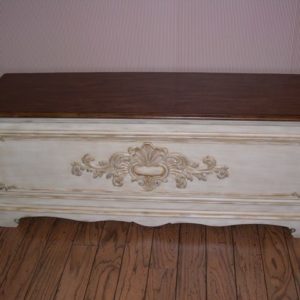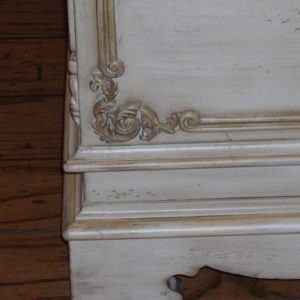I have my first possible commissioned piece and I have never carved before. The idea is to make some bookshelves to go with the chest they have. I remember seeing a mold making duplication process where you create the negative from rubber of something. Does anyone have any suggestions? I thought of duplicating the perimeter details to the side panels and bookcase front. Thanks in advance.
John
Useless things in aviation. 1. Altitude above you. 2 Runway behind you. 3 Fuel in the fuel truck.
















Replies
Jc, artist's supply Carry the stuff I believe it comes in cans (Liquid latex. Jewelers and dental supply also have similar products
One online jewelers supply company is I SHOR International.
They also have publications that teach you the techniques. I think you position the surface dead level then you spray on a 'release agent'(which prevents the rubber from sticking to the work and when the rubber sets, enables the mould to be removed without damage or distortion.)
Once this flexible mold is cured, an open form or 'surround' is placed around the mold and filled with plaster to make a rigid mould that can be used many times.
I believe law enforcement uses latex and plaster to capture foot and tire prints this way
Google up "Rubber mold making" for free videos to download also casting material etc Steinmetz
Edited 2/12/2006 2:22 am ET by Steinmetz
Since you are not making an exact reproduction of the specific piece, but a companion piece, you might find suitably similar appliques already carved. For example, http://www.vandykes.com has quite a few, and googling on something like carvings furniture, or hand carved appliques is likely to yield a large number of sources.
Thank you SteveSchoene and Steinmetz. I looked at Van Dykes already and didn't see a perfect match at first glance. It would be nice if I could duplicate it but I might be asking too much of off the shelf. I found some of those rubber mold sites and it looks like what I'm after. Only thing that concerns me is damaging the original with the release agent or mold material sticking to paint. Has anyone used the rubber mold process and what was your experiences? What would the finished molding be made from?
Thanks again,
John Useless things in aviation. 1. Altitude above you. 2 Runway behind you. 3 Fuel in the fuel truck.
http://mysite.verizon.net/respum0e/johnclanton/
Actually many "antique carvings" were done in Composition. Check out the web site of Decorators Supply Corp in Chicago. They still use their 100+ year old molds. If you are not familiar with compo, their web site talks about its production and application. If you need to do a casting fo a piece in place, check out the web site of Abatron. If you need to make the actually casting from the mold you generate, use Dunham's water putty. I've done it a number of times for pieces that I've replaced on antique furniture. With dyes - stains - glazes, I've been able to do near perfect color matches.
If you are worried about damaging the original (I would be), make a mockup and take a mould from that.
Either plaster or some of the polymer clays from an art shop are easy materials to carve because they have no grain and if you cut too much just rebuild them. Having carved a 'master', seal it with shellac and take your molds from that. This will both intro you to carving at almost no expense and take away the risk to the original.
carving tools for these materials come from either your cutlery drawer or spend $10 on a cheap lino set from the hardware.
dave
I've taken silicone molds in place on several expensive antique pieces and have never had a problem with damage. Generally I use a glycerin / water based release agent.
Mike,
Any particular place you get your casting supplies from. Silicone molds eh. Is water and glycerin the suggested release agent?
Thanks,
JohnUseless things in aviation. 1. Altitude above you. 2 Runway behind you. 3 Fuel in the fuel truck.
http://mysite.verizon.net/respum0e/johnclanton/
Moldmaking supplies ( Silicone ) http://www.abatron.com You need one with a high enough viscosity for vertical casting if you are unable to lie the piece flat. There are several types available. Also watch the date on the material as is has a limited shelf life - usually 6 months from the date of manufacture.
Casting materials - Dunhams water putty. I usually pick it up at the hardware store. It's a powder/water mixture.
Release agents - http://www.abatron.com There are several available. Only problem with a water base release is its effect on a shellac finish. If unsure use a silicone based release. Afterwards you can clean off the base with a silicone remover if need be.
Hope that helps.
Mike,
Thanks for the help. I noticed that company in FWW last night. That looks like the route I will to go.
If anyone is interested I'll post some pictures of the process. Did anyone see David Calvo on the Woodright Shop recently? I met him at the Marc Adams school last year. He strikes me as a great teacher. Had some pictures of some beautiful work.
JohnUseless things in aviation. 1. Altitude above you. 2 Runway behind you. 3 Fuel in the fuel truck.
http://mysite.verizon.net/respum0e/johnclanton/
All the stuff I have tried to do this to has been dissappointing. Absolutely lack of technique on my part I am sure because people keep telling me how straight forward it is. Havent damaged a surface yet, but havent been near a delicate one either.
Still, my faher and I restored a gilt french mirror a few years ago by applying plaster to the broken areas and carving it (the original had most of the fine detail as a moulded plaster applied to a timber base). It was certainly a good introduction to carving.
Dave
Check out this;
http://www.carveright.com/home.htm
It looks like fun.
This forum post is now archived. Commenting has been disabled